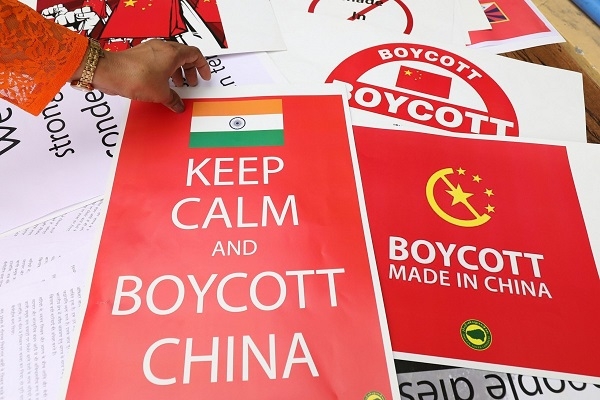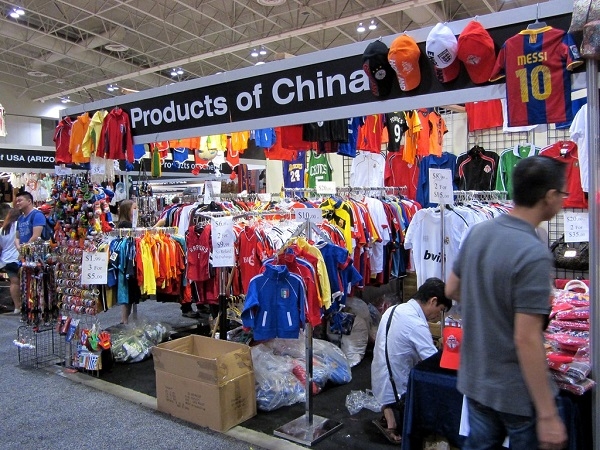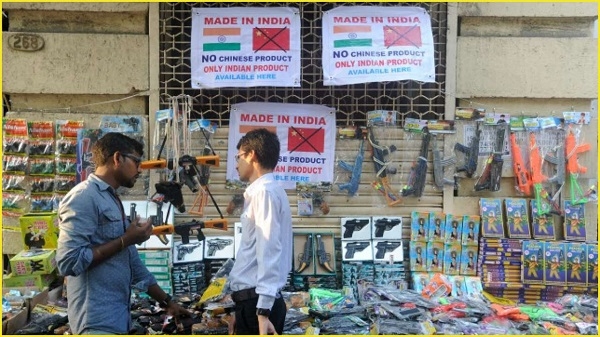Boycott Chinese Goods: Conceding Defeat on Economic Front even before the War has Begun
Total Views |
There are diametrically opposite views over the war cry “Boycott Chinese Goods” as strategic riposte on the economic front. It is conceding defeat even before the war has begun – rank cowardice. Sacrifice to secure national interests is anathema for self centric political leaders and industrial barons whose sole end objective is profits. Arrangned on either side are the spirited nationalist groups including traders association and academic economic experts and industrial barons. Also, the opportunistic political leadership is every ready to exploit the opportunities to adopt most appropriate decision to consolidate their vote banks. National security interests are the least concern for all alike. As per academic economic experts and industrial barons, the boycott of Chinese goods makes no sense and will have no impact as China is a massive economy of almost 14 trillion dollars compared to India’s 2.7 trillion. As our total import from China stands at about 100 billion dollars, even if we stop it completely, the Chinese dragon is not going to miss it much.

At the same time, there are the small businesses and start-ups that support the boycott of Chinese goods to safeguard their interests. For political leaders are guided by the mood of the nation – sentiments and emotions. Hopefully, people are upset over the “Great Betrayal” by China. So, political leader’s decisions are guided by people’s moods. What are the realities? China's economic growth since the 1980s is unparalleled. Between 1960 and 1980, its share of global GDP increased from 1.1% to 1.2%. By 2018, China's share of global GDP had increased to 13%. It is mostly based on export led growth. However, trade by itself cannot hurt Chinese security interests due to its miniscule share. Most importantly, more than 50% of India's imports from China are either capital or intermediate goods. Consumer goods, which are more likely to bear a Made in China label, have a share of less than 20%. So what? Import substitution is vital imperative for economic rise which depends on access to financial support, technology as well as export markets.
Viewed in a holistic contest, the possibility of an offensive on the economic front appears a distant prospect if considered from the narratives, discourses and debates in the media. In boxing parlance, it is “throwing the Towel into the Ring” by either the Coach or the Seconds outside the Ring conceding defeat of the boxer. Furthermore, there are only occasional narratives appearing infrequently in the media about India’s capability to wage war on the “Technology Front”. Who is again responsible and accountable for such a disastrous state in the “Technology Security” forming the key part of national security? Similarly, the status on the “Soft Power” dimension of national security is also suspect. Former diplomats and experts have cautioned the nation that there may be many nations expressing concern over Chinese transgressions/incursions contrary to mutually concluded Memorandum of Understandings highlighting the need to maintain peace and tranquilly on the LAC, but in case of either final show down either on the diplomatic front or in the military field, many would remain spectators on the sidelines.
On the internal political front, the opposition parties are hell bent upon singing their “external masters diktat” and driving a wedge in the unity vital to overcome external aggression. Despite such demoralizing overtones and odds, the “hard power” – the Armed Forces as the last bastion – is prepared to protect the “Sovereignty and Security” of the nation by valiantly wage war against Chinese PLA. Should Modi-led NDA government cave-in and surrender to the Chinese offensive or should it rally around and put up a valiant fight to protect and consolidate its sovereignty? And, who is responsible and accountable for the present dismal state of the economic power the nation which constitutes the main source of maximizing “Hard Power – armed forces” and also the “Soft Power”.
Ipso facto, the blame squarely falls on the political leadership of the nation over the last 73 years. All that the political leadership and parties have been repeatedly asserting to the “gullible masses or vote banks” is that the nation at the “cross-roads of realizing it full potential over the past 50 to 60 years; and, lately in the new millennium that the nation on the “Raising” course to become a great power. Comparative analysis of global rankings of China and India from 1949 is highlighted for the readers to draw conclusions. One, on 01 October 1949, “People’s Republic China (PRC) emerged totally war ravaged after World War II followed by the revolution. Two, according to the World Bank in 1978, China's GDP grew from $149.4 billion at 11th ranking and India’s GDP was $.137.3 billion at 12th ranking. And, Deng Xiaoping introduced the policy of “Four Great Modernizations”.

Three, by 1990, China’s GDP still was $360.86 at 11th ranking and India’s GDP was $320.98 at 12th ranking. Four, there was rapid change thereafter. In 2004, China’s GDP increased to $1955.35 at 6th ranking and India’s GDP was $709.15 at 12th ranking only. Five, ten years down the line in 2014 China’s GDP rose dramatically to $10,438.53 at 2nd ranking and India’s GDP was laggard at $2039.13 at 10th rank marginally improving from 12th ranking. Now, in 2020, China Nominal GDP is $14.14 trillion at 2nd ranking and India’s GDP is India Nominal GDP: $2.94 trillion at 5th rank. The comparative data clearly reveals that Indian economy growth remained sluggish until 2004. Even thereafter till 2014, India’s ranking marginally improving to 10th place. And in 2020, India’s ranking has moved to 5th rank. And, the target has been set to achieve US5trillion economy which due to economic recession on account of COVID-19 appears a Himalayan Challenge.
Thus, all the ruling parties are equally responsible and accountable for the “elephantine growth” until 2014. Growth in two fields is recorded to provide a perspective between China and India. For example, in the electronic fields, the Electronics Corporation of India Limited (ECIL) was established under the Department of Atomic Energy, on April 11, 1967 at Hyderabad and credited with producing the first indigenous digital computers, TDC 312 and TDC 316, solid state TV, control and instrumentation for nuclear power plants and first earth station antenna of India, to create a strong indigenous base in electronics, has woefully remained a laggard in producing semi conductor chips and even consumer electronics. Liberalization of India’s telecom industry was initiated in early 1990s. The Industry has grown over twenty times in just ten years, from under 37 million subscribers in the year 2001 to over 846 million subscribers in the year 2011, and 1.1514 billion at the end of December 2019. As of Dec 2019, India has the world's second-largest mobile phone user base with over 1.1514 billion users. The Electronic component industry was valued at $ 13.5 bn in 2015; of which Electro-mechanical segment had the highest share at 30%. Passive and active segments handled 27% and 22% share, respectively, while the remaining market of 20% was handled by the Others segment. Nearly 70-80% of the electronic components market is imports-driven.
The government has placed electronics manufacturing on high priority with a major focus on initiatives such as Digital India, Make in India and supportive FDI policies to bolster electronic manufacturing. As a result, domestic production is expected to grow to $104 billion in 2020. In contrast, it was only in 1998 that China created Ministry of Information Industry (MII) which restructured China Telecom into three parts: China Telecom (fixed-line), China Mobile (Mobile) and China Satcom (Satelite). Followed the second restructuring in 2002 geographically into north and south. Parallel to this double fission, the telecommunications division of the Ministry of Railways (MOR) established a new actor in 2000: China TieTong. According to China Daily, 286.2 million personal computers (90.6% of the global supply), 1.77 billion phones (70.6% of global supply of smartphones) and 109 million units (80% of global supply of air conditioners) were produced in 2015. Today, China is the world's largest manufacturer of mobile phones, computers and televisions, respectively producing over 90 percent, 90 percent and 70 percent of these devices in 2018. China's electronic information industry, like much of its economy, is both export-oriented and foreign capital-led. Top 10 Electronic companies include: Aigo, Haier, TCL, BBK Electronics, Huawe, Lenovo, OnePlus, Oppo, Vivo, and Xiaomi. The electronic information industry has grown three times faster than the national GDP growth rate and has grown faster than the machinery manufacturing and metallurgy industries.

Revenue for the Electric Component Manufacturing industry in China is expected to grow to total $302.6 billion. Next, in the crude steel production from 1950 onward, both China and India were at the same level of about 1 MTPA capacity. By 2017, China achieved a remarkable steel output of 803.8 MTPA producing almost 50% of world steel. Its rise was mainly from 2000 onward. China imports iron ore from India also. In case of India, there has been slow but steady growth throughout the period. The Ministry of Steel aims to increase the steel production capacity to 300 million tons by 2030-31 from 134.6 million tons in 2017-2018. Besides rich iron ore, there are 95 minerals produced by India – 4 fuel-related minerals, 10 metallic minerals, 23 non-metallic minerals, 3 atomic minerals and 55 minor minerals (bauxite, copper etc); but mostly exported instead of value addition to Japan, China and South Korea instead of producing both for export and domestic markets – loot and scoot of raw materials. India holds a fair advantage in cost of production and conversion costs in steel and alumina.
No wonder, India’s academic economic experts, particularly those in foreign countries, are harping on the present large scale dependence of imports from China and comparatively low exports to China justifying the continuation of trade relations having failed to ensure import substitution whilst they enjoyed prized posts to steer the economy. And, the industrial barons would toe their line at the cost of growth of domestic industries in all fields. For, they are only concerned with their profits and least concerned with national security interests. In retrospect, “Fraudsters of Hindustan”, who were in the forefront of “looting and scooting” the nation, are squarely responsible and accountable for the current dismal state of the nation. Dismal have been the policies, strategies and processes of the past on the economy front. Self aggrandizement was the sole interest of political leaders; but not the society or national interests. Corruption since 1980 has engulfed the nation. However, the blame also squarely rests with the “We the People” for regularly electing “Fraudsters” as their leaders to steer the course of the nation to realize its full potential. Even now it is never too late for “We the People” to send the “Dynasties, Neo Dynasties, Cronies, Criminals” masquerading as leaders to the dustbin of history. Never late than ever, Modi-led NDA government must carry out pragmatic review of the economic scenario from short, mid and long terms views and stop promoting China’s national economy security interests at the cost of India’s economy security interests.
After all, why award contracts to Chinese firms to execute infrastructure projects when India has such heavy weights like L & T, GMR and others? Similarly, there is vast scope available for domestic manufacturing to substitute Chinese imports in various fields and also for exports. Encourage and develop technology through indigenous innovation. Stop export of raw materials and ensure their exploitation by expanding capacities and encouraging setting up of additional capacities like steel production to reach 300 MTPA by 2025 instead of 2030. Similarly, fast pace growth in all other sectors. Otherwise, India can never catch up with China in advancing and consolidating economic power which is vital for maximizing “Hard” and “Soft Power” to match and face Chinese threats on all fronts of national security.

